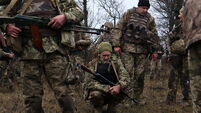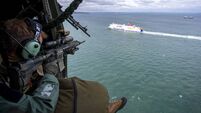Rescuers hope to reach trapped Chilean miners within 24 hours
Laurence Golborne said drilling equipment was being changed in preparation for the final push, but it is understood the rescue operation will not begin until Tuesday.
Engineers said the shaft was now just 112ft from the chamber. An elite group of rescuers was preparing last night to join the 33 trapped Chilean miners to help them return to safety.
These men – three paramedics with the Chilean navy’s special forces and 13 rescue experts with the mining company Codelco – will work in shifts during the 48 hours it could take to evaluate the men and strap them into the escape capsule for their 15-20 minute ride to the surface.
Chile’s mining minister says a shaft wide enough to provide an escape for the men trapped 2,000 feet down should reach them by today.
The paramedics will be empowered to change a list, already prepared, that suggests the order of the miners’ rescue.
The list is based on daily examinations of the miners’ physical and mental health and strength of character during more than two months of captivity, said Cmdr Renato Navarro, the Chilean navy’s submarine chief.
The first one up should be someone capable of handling a frightening setback in the narrow shaft, and describing how the next ones up might avoid problems, Navarro said.
“The most able miners will leave first – those who can better describe to the next how they might avoid the potential problems that the capsule might encounter. Then those with illnesses or who suffer from one problem or another. And the last to surface are the strongest physically or in terms of their character.”
Navarro would not reveal the list’s suggested order, since it may change.
Among the most physically fit of the miners is Edison Pena, an athlete who said he has been running 10 kilometres a day down below.
Next come those with chronic illnesses, like Jose Ojeda with diabetes and Jorge Galleguillos with hypertension, and those who are older, like Mario Gomez, at 63. Last up will be those considered most capable of handling the anxiety of being left behind as their comrades disappear one by one.
Candidates include the paramedic Yonny Barrios, or Jose Henriquez, who has been leading twice-daily prayer sessions. But many people believe the last miner up will be shift supervisor Luis Urzua, whose disciplined leadership was credited with keeping the men alive on an emergency food supply during their first 17 days without contact from the outside world.
“It could be Urzua, but it’s still not confirmed. The concept of a captain being the last one to abandon ship could be applied,” Navarro said. Those who know Urzua are sure he’ll insist on going last.
“He’s going to prefer that his team leaves ahead of him,” said Robinson Marquez, a neighbour and former coworker of Urzua’s who describes him as extremely patient and calm.
“He’s going to make sure that all of the men leave, and leave well,” added Robinson’s wife, Angelica Vicencio, who has led a nightly vigil outside the Urzua home in Copiapo.
“He’s a very good guy – he keeps everybody’s spirits up and is so responsible – he’s going to see this through to the end.”
When the last trapped miner goes up the shaft, two men will be left behind, and then one. Navarro said it will most likely be one of the paramedics.
These paramedics are “among the best in Chile when it comes to rescues,” Navarro said.
While the “Plan A” and “Plan C” drills have been slowed by efforts to keep them on target, “Plan B” resumed with fresh drill bits carving through the final 291 feet.













